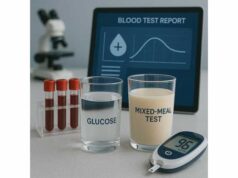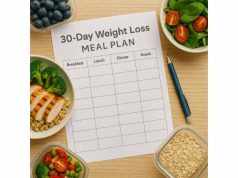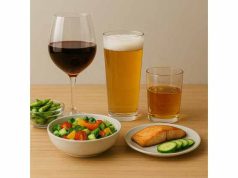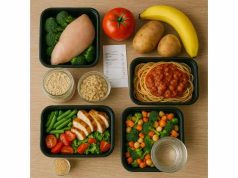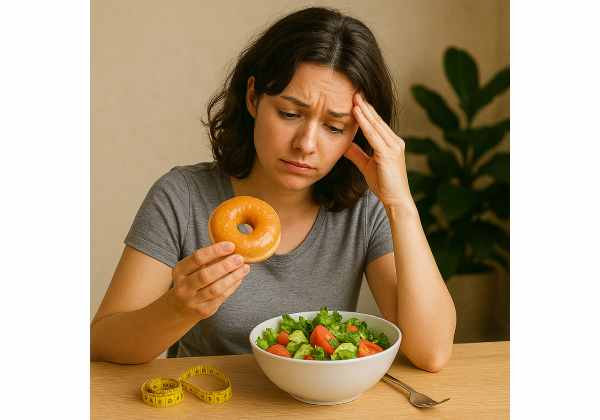
The scale slows for predictable reasons. Most “plateaus” come from quiet calorie creep, under-eating protein, low fiber, inconsistent weekends, and lifestyle factors like sleep and stress. The good news: you can correct course without extreme rules. This guide explains the most common diet mistakes that block progress and shows precise fixes you can apply this week. If you need a refresher on daily energy needs and how protein, carbs, and fat fit together, skim our concise primer on calories, macros and meal plans before you dive in. Then use the step-by-step corrections below to turn small changes into steady results.
Table of Contents
- Diet mistakes that stall loss
- Calories: too low or high
- Skewed macros and low protein
- Low fiber and food volume
- Weekday discipline, weekend rebound
- Liquid calories and alcohol
- Sleep, stress, and plateaus
- Frequently Asked Questions
Diet mistakes that stall loss
Plateaus are not proof that your body “won’t lose weight.” They signal a mismatch between intake, output, and appetite control. The biggest culprits are mundane: unlogged bites and sips, portions that drift larger, meals light on protein or fiber, and inconsistent routines between weekdays and weekends. Each one nudges you from a small calorie deficit back toward maintenance.
Start with energy balance. Weight changes when average intake over weeks falls below your energy needs. That gap can be modest—300–500 calories per day is enough for many adults. Early in a diet, that deficit may come naturally as you cut obvious extras. Later, your behaviors adapt: you snack a bit more, pour oil a bit heavier, or skip meal prep and order takeout. Meanwhile, your body adapts too—you weigh less (so you burn less), and you unconsciously move a little less when dieting. These factors shrink the original deficit even if your “plan” looks the same on paper.
Next, consider meal composition. Protein preserves lean mass and steadies hunger. Fiber adds volume and slows digestion. When dinners drift toward refined carbs and added fats, meals can hit the same calories with far less fullness. The result: grazing at night and the sense that “nothing works” when the issue is basic satiety.
Finally, look at structure. Successful plans are boring in the best way: repeating breakfasts, simple lunches, and 3–5 reliable dinners you rotate. They use standard shopping lists, batch cooking, and a few sauces to keep flavors fresh. When people stall, their routines usually erode first. Rebuild the routine, then make small, targeted adjustments.
Use the sections that follow as a checklist. Fix one mistake at a time for 10–14 days, watch the trend (weight, waist, or how clothes fit), and then decide whether to adjust again. If you want a big-picture refresher before making changes, our safe weight loss guide summarizes the essentials and how to set expectations week by week.
Calories: too low or high
Two opposite errors can stall progress: chronic under-eating that backfires and quiet over-eating that erases the deficit.
When calories are too low
Very low intakes feel productive at first. After a few weeks, you may notice low energy, strong cravings, and spontaneous snacking. You move less without trying, you push workouts, and evenings become hard to manage. The practical effect is a smaller weekly deficit than you expect, with more variability day to day. If your average intake over seven days keeps landing near maintenance because of rebound eating, slower, steadier targets usually work better.
When calories creep high
The math often fails in the margins: a “tablespoon” of peanut butter that is actually 2 tablespoons, a splash of oil that is closer to 2 teaspoons than 1, or a few hundred weekly calories from bites, sips, and samples. Alcohol and weekend meals add more variability. None of these choices are “bad”; they just change the numbers.
Fixes that work
- Set a realistic range. For many adults, a 300–500 calorie daily deficit is sustainable. Recalculate as your weight changes. Use a 14-day average rather than single days to judge progress. If you need help picking a number, revisit your daily calorie target and adjust for activity.
- Use “guardrails,” not rigid rules. For 2–4 weeks, log oil, nuts, cheese, sauces, and sweets. These are high-calorie per bite and easy to underestimate. Keep portions consistent—measuring spoons help.
- Add a small planned snack when you under-eat at meals. A 150–200 calorie protein-focused snack (Greek yogurt, cottage cheese with fruit, a protein shake with berries) reduces unplanned evening grazing.
- Create “default plates.” Decide on two breakfasts, two lunches, and three dinners that hit your numbers. Repeat them on busy days so estimates stay stable.
- Audit weekends. If your weekly average stalls, check Friday night through Sunday afternoon first. One large dinner and a few drinks can cancel a week’s small deficit without you noticing.
When to adjust calories
If body weight, average waist, or clothing fit have not budged after 3–4 weeks of truly consistent behaviors, reduce your daily target by 100–150 calories or add a short walk after meals. Smaller changes beat drastic cuts because they preserve adherence and energy.
Skewed macros and low protein
Calories set the ceiling; macros determine how you feel under that ceiling. Plateaus often trace back to low protein or a lopsided split of carbs and fats that undermines satiety.
Protein: the cornerstone
Aim for 1.6–2.2 g/kg body weight per day (or 25–40 g per meal). Protein blunts hunger, preserves lean mass in a deficit, and slightly increases the energy cost of digestion. If your breakfast is toast and fruit and lunch is a light salad, dinner has to carry the load—which is risky for appetite control. Distribute protein across the day and you will feel more stable.
Carbs and fats: choose quality, balance quantity
Carbohydrates are not the enemy. High-fiber sources (beans, lentils, whole grains, potatoes with skin, fruit) bring volume and micronutrients. Fats are flavorful and support hormones, but they are energy-dense. Many “healthy” plates stall progress because they over-rely on oils, nuts, cheese, and creamy sauces. The calories add up fast without much volume.
Fixes that work
- Set a practical macro split. A common starting point while dieting is about 30–35% protein, 35–45% carbs, 20–30% fat. Adjust for preference and training. Use our guide to smart macro ratios if you want examples by body size and activity.
- Anchor each meal with protein. Examples: 250 g Greek yogurt, 120–170 g chicken or fish, 170–200 g tofu or tempeh, or 1–1½ cups beans plus a yogurt- or tofu-based sauce.
- Make fiber automatic. Target 25–38 g per day. Build dinners that provide 8–15 g from vegetables, beans, and whole grains.
- Watch “invisible” fats. Use 1–2 teaspoons of oil per serving, measure nut butters, and sprinkle cheese rather than blanketing dishes. Build flavor with acids (lemon, vinegar), spices, and umami (miso, Parmesan, tomato paste).
- Leverage protein snacks. Keep 1–2 options on hand that give 15–25 g protein with modest calories: cottage cheese with berries, edamame, jerky, or a whey or soy shake.
What progress looks like
When protein rises and fats are measured, most people report steadier hunger and fewer late-night raids of the pantry. Even if scale weight is slow to respond, waist measurements and energy often improve within two weeks—both are early signs that your plan is now working even before the scale shows it.
Low fiber and food volume
If meals hit your calorie target yet you still feel hungry, look to fiber and volume. Many “clean” diets undershoot fiber by swapping out beans, grains, and potatoes for extra oil or protein. The plate looks small, digestion is fast, and cravings rise in the evening.
Why volume matters
Stretch and nutrient signals from the gut help your brain register fullness. Vegetables, legumes, whole grains, and fruit provide water and fiber that increase stomach stretch at low calorie cost. By contrast, energy-dense fats give flavor and satiety later, but they do little for immediate meal volume.
Fixes that work
- Use a volume-first plate. Fill ½ the plate with non-starchy vegetables (roasted broccoli, peppers, green beans, salads), ¼ with lean protein, ¼ with high-fiber carbs (beans, lentils, whole grains, potatoes with skin).
- Add a legume by default. Fold ½–1 cup beans or lentils into stews, salads, and pasta. They deliver 7–15 g fiber and 10–18 g protein per cup.
- Choose high-volume sides. Swap 1 tablespoon of oil (~120 calories) for a side salad with vinaigrette or an extra cup of vegetables. You will feel fuller for the same calories—or fewer.
- Keep “quick volume” on hand. Frozen vegetables, pre-washed greens, jarred salsa, tomato paste, and canned beans turn any protein into a satisfying meal in minutes.
Want a deeper dive into building big, satisfying plates that still fit your numbers? See our guide to high-volume foods for examples, swaps, and meal ideas.
Signs you have enough fiber
Regular digestion, less snacking after dinner, and a stable morning appetite. If you are increasing fiber, add it gradually and drink water to avoid discomfort. Most adults feel best between 25–38 g/day, with 8–15 g coming at dinner.
Weekday discipline, weekend rebound
You can “do everything right” Monday through Thursday and still stall if weekends swing wide. Social meals, takeout, late nights, and drinks make it easy to overshoot targets by 1,000–2,000 calories across Friday to Sunday. That is enough to cancel a modest weekday deficit.
Why weekends derail progress
Structure drops. Meal timing drifts. You snack during errands, skip protein at lunch, and arrive at dinner hungry. Alcohol lowers restraint and pairs with calorie-dense foods. None of this means you must avoid weekends—it means you need light structure that preserves your average.
Fixes that work
- Plan two “bookend” meals. Choose a high-protein breakfast and a fiber-rich lunch on Fridays and Saturdays. Anchoring those meals steadies appetite before social dinners.
- Set a drink budget. Decide your number before you go out. Alternate with water or diet soda. Choose lower-calorie pours (light beer, dry wine, spirits with soda or diet mixers).
- Order like a coach. Prioritize a protein entrée, ask for sauces on the side, and add a vegetable side or salad. Share fries or dessert rather than ordering your own.
- Use “damage control” movement. A 20–30 minute walk before or after meals helps manage appetite and blood glucose, especially when you eat out.
- Batch cook Sunday. A little prep resets the week. If you need a template that fits real life, our one-hour weekend prep builds several dinners and lunches with minimal effort.
Progress mindset
Do not grade weekends as “good” or “bad.” Look at the weekly average. If you are trending the right way, keep your setup. If not, change one variable (drinks, late-night snacking, or portion size at dinner) and retest for two weeks.
Liquid calories and alcohol
Your log may look tidy while liquids push you out of a deficit. Coffee drinks, juices, smoothies heavy on nut butter, full-sugar sodas, energy drinks, and alcohol move fast and satisfy poorly. Alcohol also reduces inhibitions and sleep quality, making it easier to over-eat late.
Fixes that work
- Audit beverages for 7–10 days. Include creamers, syrups, and “healthy” smoothies. Many add 150–400 calories without much fullness.
- Keep hydration simple. Water, sparkling water, black coffee, unsweetened tea, or diet beverages during your deficit.
- Smart smoothie rules. Use fruit (1 cup), Greek yogurt or protein powder, and a vegetable (spinach, cucumber). Limit nut butter to 1 teaspoon or add chia for fiber.
- Alcohol with intent. Decide how many drinks you want before you go out. Eat protein and fiber first. Choose spirits with soda, light beer, or a small glass of dry wine. Skip creamy, sugary cocktails.
For a deeper look at strategies and lower-calorie choices when drinking, see our guide to alcohol and calorie control.
A useful experiment
Go 14 days alcohol-free. Many people notice better sleep, lower evening appetite, and easier adherence. If fat loss speeds up, you have your answer; if not, keep the habit that makes you feel best and focus elsewhere.
Sleep, stress, and plateaus
Diet talk often ignores sleep and stress, yet both shape hunger hormones, cravings, movement, and training quality. Short sleep drives appetite toward calorie-dense foods. High stress pushes convenience eating and late-night snacking. These forces can add 200–400 calories a day without you noticing.
Fixes that work
- Protect sleep first. Aim for 7–9 hours. Keep a consistent wake time, darken your room, and stop caffeine by early afternoon. A short pre-bed walk or stretch can help you unwind.
- Use meal structure to reduce decisions. Breakfast and lunch on autopilot, dinner from a short list. Fewer choices mean less decision fatigue when stress runs high.
- Stack tiny movement. Short walks after meals, a few sets of bodyweight exercises during breaks, or standing while on calls. Movement stabilizes appetite and mood.
- Create a “late-night plan.” Decide what you will eat if hunger hits after dinner: Greek yogurt and berries, a protein shake, or vegetables with hummus. Keep options visible and easy.
- Measure trends, not single days. Track weekly averages for weight and steps. Use waist or clothing fit as a second metric when the scale bounces.
When to seek support
If stress eating or sleep problems persist, talk with your clinician, a registered dietitian, or a therapist. Simple nutrition changes help, but persistent insomnia or high stress deserves direct care.
Frequently Asked Questions
Why did my weight loss stop even though I am eating the same?
Your early deficit likely shrank. You weigh less (so you burn fewer calories), portions drifted, and spontaneous movement fell. Audit oils, drinks, and weekends for two weeks, raise protein and fiber, and consider a small 100–150 calorie adjustment if trends stay flat.
Should I cut calories more when progress stalls?
Start smaller. First, tighten logging on oils, snacks, and drinks, and hit 25–40 g protein and 8–15 g fiber at dinner. If measurements do not change after 3–4 weeks of consistent habits, reduce daily intake by 100–150 calories or add short walks.
How much protein helps during a diet?
Most adults do well with 1.6–2.2 g/kg body weight per day, spread over meals. That typically looks like 25–40 g per meal and a protein-forward snack. This level improves satiety, preserves lean mass, and makes lower-calorie meals feel more filling.
Do I need to avoid carbs at night to lose weight?
No. Weight loss depends on total intake, not carb timing. In the evening, choose high-fiber carbs like beans, lentils, whole grains, or potatoes with skin, and pair them with lean protein and vegetables. Keep portions modest if you prefer lighter dinners.
Can alcohol fit while dieting?
Yes, with structure. Set a drink budget, eat protein and fiber first, and choose lower-calorie options (light beer, dry wine, spirits with soda). Alcohol reduces restraint and sleep quality, so many people progress faster when they limit it to planned occasions.
How long should I try a change before reassessing?
Give each change 10–14 days. Track weekly averages for weight and waist. If nothing budges after 3–4 weeks of consistent behaviors, adjust calories by 100–150 or add movement. Patience protects adherence and prevents rebound over-eating.
References
- Overview | Overweight and obesity management | Guidance | NICE — 2025 (Guideline)
- Systematic review and meta‐analysis of protein intake to support muscle mass and function in healthy adults — 2022 (Systematic Review)
- Fiber | Dietary Reference Intakes: The Essential Guide to Nutrient Requirements | The National Academies Press — 2006 (Seminal Reference)
Disclaimer
This article provides general education and is not a substitute for medical care. Always consult your healthcare professional for personalized advice, especially if you have chronic conditions, take medications that affect appetite or blood glucose, are pregnant or breastfeeding, or have a history of disordered eating.
If this guide helped you: please share it with someone who is working toward healthier habits, and consider following us on Facebook, X, or any network you use for practical nutrition tips and weekly menu ideas.

